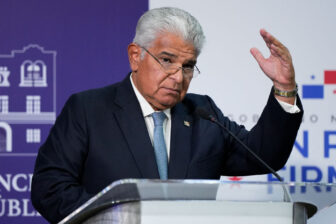PANAMA CITY—For over two weeks, Panama has been rocked by anti-government protests. What began as a teachers’ strike on April 23 has grown to include construction workers, students, nurses, and banana pickers. On Sunday, Indigenous groups announced they were ready to blockade major roads. But what do they want?
Elidya Espinosa García, president of a nursing union, said the government should “reflect on the critical situation” its social security reform had created for workers.
“For me, it’s the mining issue,” said Linnette Jaén, a member of the Sal de las Redes protest organization, in reference to President José Raúl Mulino’s plans to potentially reopen the massive Cobre Panamá mine.
Arnulfo Montilla, a professor, took to the streets to reject recent agreements signed with the U.S. He said they show Mulino “doesn’t give a damn about all the generational struggles that have led to us being sovereign over our national territory.”
These new deals, signed with U.S. Secretary of Defense Pete Hegseth in April, have provided a powerful uniting force to the protests. They establish “joint operations” centers and “cost-neutral” passage of U.S. warships through the Panama Canal—and are widely viewed as a humiliation: a violation of the spirit, if not the letter, of the Canal Neutrality Treaty.
Some observers fear disruptions on the order of 2023, when frustration with perceived corruption and incompetence in the administration of former President Laurentino “Nito” Cortizo boiled over into nationwide demonstrations that cost the economy an estimated $2 billion and coalesced behind the single demand of shuttering the Cobre Panamá mine. A Supreme Court ruling subsequently closed the $10 billion mine that had accounted for 5% of Panama’s GDP, delivering a major win for protesters and a major fright to investors.
The current demonstrations are gaining steam in the capital and have all but shut down the western province of Boca del Toro, where on Monday Chiquita Brands closed one of its plantations indefinitely following $10 million in lost exports. But even though they could grow, they are unlikely to be as disruptive or force major concessions that satisfy the protestors’ diffuse demands.
A tough job
Given the challenges Mulino inherited upon taking office in July 2024, he was always likely to face energetic opposition to his reforms. Despite dire warnings, the two previous governments failed to overhaul the country’s insolvent social security system. On March 18, Panama’s National Assembly passed a reform that increased employer contributions and requires payments from some informal workers, but stopped short of raising the pension age, which stands at 57 for women and 62 for men.
Reopening the mine is also seen as key to rebooting the Panamanian economy. Closing the mine cost 30,000 jobs, 5% of GDP, and a higher debt burden due to the subsequent loss of investment grade. On April 23, Mulino said his government was considering options to reopen the mine without passing a new law through the assembly or holding a referendum. “Let’s be smart and get the most benefit as Panamanians from a mine we already have,” he told the press. Analysts have welcomed Mulino’s handling of the economy. The IMF has recently revised Panama’s 2025 growth projection upward to 4%, and projects inflation at just 0.5%.
Both proposals are unpopular, but there seems space to compromise. According to a poll by DoxaPanama, 82% of Panamanians are opposed to the social security reform, but there was significant misunderstanding of what it entailed (55% believed retirement age had been increased). And around half of those surveyed would support reopening the mine if it is done in an environmentally responsible way.
If it had employed better messaging, Mulino’s government may have been able to contain the protests. Instead, careless rhetoric has fired up his opponents. He has been dismissive of environmental protests against the mine, and as the protests began to gain momentum, he said the University of Panama community should “behave like students, not terrorists.”
The signing of the agreements with the U.S. (and Trump’s continued comments about “taking back” the canal) have further fueled the protests, led to flurry of lawsuits from Panamanian lawyers, and prompted key opposition leaders to sign a joint declaration for national sovereignty. By the end of April, Mulino’s disapproval rating stood at 68%.
A fine line
Panama’s civil society is well organized, well-versed in taking to the streets, and mistrustful of perceived backroom dealings. The mine was opposed not only for its environmental impact, but also because its contract was negotiated in an especially secretive manner.
But the social security reform was passed by the members of the National Assembly elected just last year. This was representative democracy in action, not a closed-door international contract. Moreover, the Supreme Court’s 2023 decision did not—as some protestors believe—ban mining in the country. It simply ruled that the contract, awarded without a public tender, was unconstitutional.
Mulino’s strategy appears to be to wait out the protests, and hope they have been sapped of energy by the time the Supreme Court makes its ruling on the deals with the U.S., expected in late June at the earliest. There are several factors working in his favor.
Although unpopular, Mulino doesn’t inspire the same contempt that the population held for the previous administration. Popular support for the movement is likely to sag as small and medium-sized businesses feel the squeeze. A serious injury inflicted on a four-year-old girl by protestors outside the University of Panama has also soured opinion toward the movement’s more violent elements. Meanwhile, Sal de las Redes appears to have lost credibility in the eyes of many for refusing to Mulino’s offer for dialogue. So far, opposition figures have yet to put their full weight behind the protests.
It seems unlikely, therefore, that the protests can maintain their current intensity until the Supreme Court rules on the U.S. agreements. Mulino seems to recognize the need to tread lightly. In recent days, he has moderated his tone. “This president is not perfect,” he said at an event to announce a new rail project last week, “I’m sorry, I have a short fuse.”










